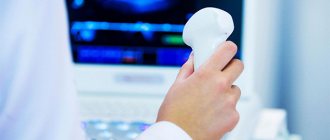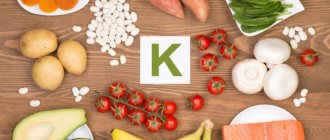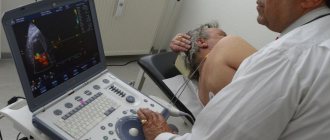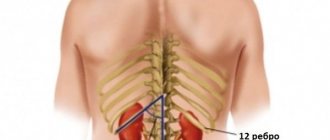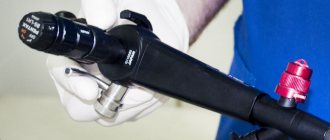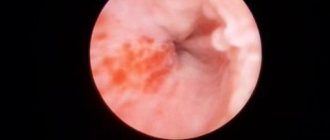Ultrasound examination of the abdominal organs
Ultrasound examination makes it possible to diagnose hollow and parenchymal organs. The abdominal cavity contains the following organs: liver, kidneys, spleen, intestines and stomach. The procedure is prescribed by the attending physician in cases where the patient has complaints of pain in the abdomen, increased gas production, a bitter taste in the mouth, or heaviness in the stomach.
If the patient has disturbances in the functioning of the internal organs of the abdominal cavity, ultrasound data will help make an accurate diagnosis. In cases where there is suspicion of cancer, an ultrasound examination will help confirm the presence or absence of a diagnosis.
Also, this type of diagnosis allows doctors to detect cysts, cirrhosis, hepatitis, kidney stones, cholecystitis and inflammatory processes occurring in the abdominal organs.
Introduction
Everyone knows that ultrasound remains to this day not only one of the most informative examination methods, but also a non-invasive, painless and safe way to find out all the details about the patient’s health and condition.
However, not everyone knows, for example, that you should not eat or drink before an abdominal ultrasound, how best to prepare for it so that the data is as informative and reliable as possible, and what the diet should be before such an examination as an ultrasound.
The main obstacle to the procedure is the presence of excess air in the intestines, so the patient’s primary task is to remove it . The outcome greatly depends on the thoroughness of the preparation.
How to prepare for ultrasound diagnostics
The intestines and stomach are hollow organs, which means they contain air. Therefore, these organs are difficult to study. In order for an ultrasound examination to provide a reliable picture of the condition of the internal organs, a number of conditions must be met on the eve of the procedure. Before the ultrasound you should:
- follow a special diet;
- notify your doctor about the medications you are currently taking;
A special diet before the procedure is designed in such a way that all foods that contribute to gas formation are excluded from the diet. At this time it is forbidden to eat:
- black bread;
- milk and dairy products;
- sparkling water;
- legumes;
- cabbage;
- grape;
- apples;
- plums;
- fresh bakery.
If the patient has a tendency to flatulence, the attending physician may prescribe medications. A couple of days before the test, you can drink activated charcoal or Espumisan, this is done in order to eliminate gas-forming processes in the intestines. Your doctor may prescribe medications that improve digestion. In this case, Mezim or Pacreatin will be effective.
On days you are on a diet, it is recommended to drink more fluids. It is useful to drink still water or tea without sugar.
On the eve of the procedure, it is advisable to do a cleansing enema. A couple of hours before the ultrasound, you can drink 5-6 tablets of activated carbon.
You cannot eat before the procedure. The last meal should take place six hours before the start of the study. Food should not be too fatty.
General preparation
Like any diagnostic procedure, kidney ultrasound has a number of features of the preparatory stage. Experts recommend adhering to the following rules:
- adjust the diet - exclude all foods that can increase gas formation, for example, rutabaga, legumes, cabbage, black bread;
- cleanse the intestines in a timely manner - if there is a tendency to constipation or diarrhea, carry out drug therapy;
- avoid excessive physical activity;
- stop taking a number of medications - discuss their appropriateness with your doctor, which ones you can abstain from for 2-3 days.
In most cases, no special preparation is required on the day of the test. If an ultrasound is scheduled for the morning, then the person will be on an empty stomach, because people do not tend to eat at night. It is enough to refrain from breakfast.
The exception is people with diabetes - they are allowed a light snack.
What to eat before an abdominal ultrasound
A very important question that should worry any patient is “How long should you not eat before an abdominal ultrasound?”, but here let’s look at everything in detail without haste.
You will have to start preparing the intestines and stomach for the study three days before the scheduled procedure. These days, as mentioned above, you need to follow a diet. What foods should be included in the diet during this period? You can eat poultry or beef, you can eat lean fish. Among porridges, it is better to give preference to buckwheat and oatmeal.
It is not recommended to eat a lot. It is better to take small portions and take them every three hours. You need to drink enough liquid. You will need to drink at least one and a half liters per day.
If you are going to have an ultrasound of your kidneys, you will need to drink up to 6 glasses of liquid an hour before the test. It is important that the bladder contains fluid.
Drinking regime
Preparatory instructions rarely mention whether you should drink water before a kidney ultrasound? In general, the drinking regime at the preparatory stage should be plentiful and correspond to the age and state of health of the person.
It is allowed to drink green tea and fruit drinks, natural vegetable and fruit juices, preferably freshly prepared. Drink water abundantly and regularly, but avoid gases. Because sweet carbonated drinks, as well as kvass, enhance fermentation processes in the intestinal loops.
Avoid alcoholic beverages. Even low-alcohol drinks – white wine, beer – increase kidney activity, which will distort ultrasound information. If there is a feast coming up, during which it will not be possible to stop drinking alcohol, it is better to postpone the examination procedures to another day.
In cases where, in addition to the kidneys, it is necessary to evaluate the condition of the adrenal glands, as well as the bladder, an indispensable condition is to take 2-3 glasses of clean water. Transabdominal examination will be more informative. It would be a good idea to take 0.5 liters of juice with you and take it 15–20 minutes before visiting the ultrasound room.
Special diet before ultrasound for children and pregnant women
Little ones can be fed lightly before the ultrasound. It is important that the food is light and easily digestible. The last meal is allowed no later than three hours. Otherwise, it will not be possible to conduct a high-quality examination and the procedure will have to be repeated again.
Older children can eat 4 hours before the procedure. If after this time the child becomes hungry, you can offer him some water. But you should not take liquid an hour before the test.
A gentle diet is also recommended for pregnant women. Most often, the procedure is prescribed in the morning to make it easier for a woman to endure a hunger strike.
What menu is recommended before an ultrasound?
Compliance with the diet is mandatory when examining the organs of the genitourinary system and gastrointestinal tract. Products that increase gas formation include:
- bakery products using yeast;
- alcohol;
- soda – lemonade, mineral water;
Coffee and cakes will have to be excluded from the diet
- sweets;
- smoked, spicy, salted, fried foods;
- fatty meats;
- milk, cottage cheese with high fat content;
- porridge with milk;
- junk food (burgers, fries);
- strong tea or coffee;
- juices from the store;
- vegetables, coarse fruits (cabbage, onions, sorrel, turnips, radishes, radishes, gooseberries).
You are allowed to eat low-fat foods:
- cereals – buckwheat, millet;
- milk and its products with low fat content;
- chicken;
- vegetable soups;
- tea with chamomile.
Before an ultrasound, you can safely eat buckwheat porridge.
It is best to cook food by steaming or in the oven.
An approximate menu for 1 day is shown in the table.
| Eating | Products |
| Breakfast | 1 boiled egg, green tea |
| Snack | Low-fat cheese, a glass of clean still water |
| Dinner | Lean meat, boiled in slightly salted water (or steamed), compote |
| Afternoon snack | Porridge |
| Dinner | Lean fish, steamed or baked in foil, still water |
Colon cleansing before the procedure
Before the ultrasound procedure, you will need to cleanse the intestines. This is done on the eve of the study, but no later than 18 pm. Instead of an enema, you can use alternative methods, which include taking laxatives or using microenemas. Currently, pharmacies sell very easy-to-use microenemas “Microvax” or “Norgalax”.
These drugs will help cleanse your stomach without unnecessary hassle.
Disadvantages of the method
Ultrasound is not a unique method of research and diagnosis. Therefore, it has its significant disadvantages. The main ones include:
- Compared to MRI or CT, this method has a fairly low image resolution on the screen.
- Ultrasound cannot simultaneously show a complete diagnostic picture due to the small examination area.
- All human internal organs are heterogeneous, so the ultrasound image contains a large amount of noise and picture defects.
- In order to get the desired result, you must adhere to a diet, take the necessary medications and come for diagnostics on an empty stomach.
Features of the procedure
Usually ultrasound is prescribed in the morning. This is the most appropriate time to conduct the study, because it is carried out on an empty stomach. If the procedure is scheduled for the afternoon, a light breakfast is allowed, but no later than eight hours before the start of the study, but it would still be better to limit yourself to drinking weak tea without sugar.
Ultrasound examination is a fairly harmless and painless procedure. There are no restrictions on its implementation. Ultrasound can be done exactly as many times as needed to obtain accurate information about the condition of the internal organs of the abdominal cavity.
Bloating food
Conventionally intumescent products can be divided into 2 categories (based on origin):
- vegetable;
- animals.
Pasta, bakery and other products containing wheat flour are considered gas-forming food products. They contain gluten, a complex protein that can cause bloating and flatulence. The list can be supplemented with rye and barley. These cereals contain large amounts of plant-based fiber and gluten.
Substances that provoke flatulence are present in almost all types of cabbage (cauliflower, Brussels sprouts, kohlrabi, broccoli, cabbage). In order for the body to break down this vegetable faster, it is recommended to subject it to heat treatment.
Onions, green onions, and fresh garlic provoke flatulence. They contain a number of biological compounds that promote bloating.
Gas-forming products of animal origin include some types of meat and dairy products. They contain a large amount of fat. Products in this category are recommended to be consumed in small quantities no more than 3-4 times a week.
